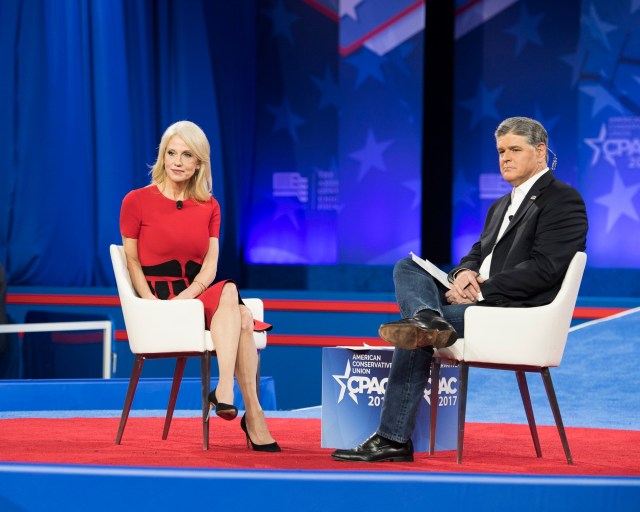Kellyanne Conway being interviewed by the biggest cheerleader for Trump in the US media, Sean Hannity (at the American Conservative Union’s 2017 Conservative Political Action Conference (CPAC), Maryland, February 22, 2017. Michael Brochstein/SIPA USA/PA Images.

America’s most important journalists live in a gilded bubble. Whether it is in television or print news, journalists who “make it” earn a tremendous amount of money – and that’s killing American journalism.
The New York Observer publishes an annual “media rich list” that details how much our journalists earn. Fox News show host Sean Hannity (pictured, right) topped the 2016 list last year with over $29 million in salary from two programmes.[1. Howard Altman, ‘The hosts with the most : the best paid New Yorkers in TV news’, The New York Observer, 16 November 2016 https://observer.com/2016/11/the-hosts-with-the-most-the-richest-new-yorkers-in-tv-news/] His progressive counterpart, MSNBC host Rachel Maddow, finished tenth by earning “only” $7 million.
This is a staggering amount of money. Mr. Hannity’s earnings, for example, would have placed him in the seventeenth slot among corporate CEOs in America, according to a New York Times analysis.[2. Jon Huang and Karl Russell, ‘The Highest Paid CEOs in 2016’, The New York Times, 26 May 2017 https://www.nytimes.com/interactive/2017/05/26/business/highest-paid-ceos.html] He made more in 2016 than current U.S. Secretary of State Rex Tillerson did running Exxon Mobil, one of the largest companies in the world. He also earned more than the CEO of General Motors, America’s largest automobile company, and Howard Schultz, CEO of the globally ubiquitous Starbucks.
These people do not get to this level of wealth and status by delivering thoughtful, in-depth critiques of policy issues. Hosts like Hannity and Maddow entertain a consistent viewer base by reinforcing their biases. Guests on shows like these aren’t interviewed so much as either skewered like lambs to slaughter, if they represent views disfavored by the host, or used as props providing “expert” opinions that agree with the host’s. This format informs in the same way a pure sugar diet feeds a body: you get a lot of quick energy but very little that is truly nutritious.
A££ The New$ That’s Fit to Print
Print journalists also make incredible sums of money. While the salaries of leading columnists such as the New York Times’ Thomas Friedman or Paul Krugman are often “only” $300,000 or so,[3. Andrew Stiles, ‘Poor Paul Krugman’, The Washington Free Beacon, 21 April 2014 https://freebeacon.com/blog/poor-paul-krugman/] these stars of the printed page earn much more from book sales, contracts as consultants to television networks, or speaking fees in the neighborhood of $50,000 per talk. The fact that they won’t compete with America’s top fifty corporate CEO’s for compensation doesn’t mean they aren’t well ensconced in what some often call “the top 1%”.
Again, you do not get to this point by delivering unpredictable commentary. They are essentially advocates, lawyers who make the best cases possible for their points of view. The liberal economist and columnist Paul Krugman, for example, is regularly hoisted upon his own petard by conservatives pointing out his contradictions in the service of bashing Republicans.[4. See e.g. https://blogs.spectator.co.uk/2013/10/niall-ferguson-paul-krugman-gets-it-wrong-again-and-again-and-again-why-does-anyone-still-listen-to-him/ ] But let’s not just pick on Paul: plenty of journalists on the right have spent the better part of the last year contorting themselves into pretzels to explain why Donald Trump is the perfect expression of Republican Party or conservative principles.
Failure to go along with the herd can be catastrophic. Mark Lasswell had been the opinion page editor at the Wall Street Journal, one of the most important jobs in conservative journalism. As the paper started to move to a pro-Trump position following the Donald’s capture of the GOP nomination, many reports allege that Lasswell, who was allegedly willing to publish pieces critical of Trump, was essentially forced out.[5. Rosie Gray, ‘Conflict over Trump forces out an opinion editor at The Wall Street Journal’, The Atlantic, 10 February 2017 https://www.theatlantic.com/politics/archive/2017/02/conflict-over-trump-forces-out-an-opinion-editor-at-the-wall-street-journal/516318/] Far easier for a journalist to run with the herd than to courageously buck it.

Gossip with microphones
Less formally partisan or opinionated journalism, however, is little better. They, too, make huge amounts of money. And while partisanship doesn’t butter their bread, their reliance on “in-the-know” sources means they rise by feeding other people’s agendas. Thus they rarely provide critical analysis of what is reported: instead, the latest leak is breathlessly fed to the people as gospel truth. Again, journalism provides a sugar high but few nutrients.
This reliance also means Americans are constantly fed with stories about internal power struggles, especially in the White House. If official X is your primary source and official Y is trying to displace X, this matters intently to you as your pipeline into juicy Presidential material may dry up. Who’s in and who’s out in the White House therefore matters terribly to political journalists, hence all the stories on whether Steve Bannon or Jared Kushner is ascendant in their supposed battle for the President’s ear.[6. See, e.g., https://www.vanityfair.com/news/2017/04/jared-kushner-steve-bannon-white-house-civil-war; https://www.nytimes.com/2017/04/06/us/politics/stephen-bannon-white-house.html; https://www.cnbc.com/2017/04/17/trumps-game-of-thrones-heres-what-you-mightve-missed-in-the-bannon-vs-kushner-battle-commentary.html ] How this information helps American citizens decide what they think about policies that might affect their lives is at best obscure.
Today’s gladiators
These factors combine to create an adversarial style of reporting more akin to a Roman ampitheatre than to the voting booth. Political or policy questions are always personalised; someone wins or loses. There are also always only two sides to any battle: viewers or readers who want neither Team Red nor Team Blue to win are ignored or implicitly told to get with the programme.
The coverage of the proposed Republican changes to Obamacare is a case in point. These changes will affect the availability and cost of health insurance to tens of millions of people, literally in some cases a matter of life or death. Instead of discussing the plan’s specific details, media coverage instead focuses on whether the Republicans can garner 51 votes in the Senate to procure its passage. Readers who want to know mundane details like what health services might be covered under plans financed by the Senate GOP proposal have to try to search for this information like Stanley had to march through the Congo to find Livingston.
Whither democracy?
Newspaper subscriptions are in steep decline, although the way the media have turned coverage of President Trump into a reality show where we are invited each day to see if he has been voted off our political island is producing huge profits for anti-Trump outlets.[7. Insert FT link] The number of viewers of one of the three major networks’ nightly news programmes has plummeted since 1980[8. https://www.stateofthemedia.org/2011/network-essay/data-page-5/ ; https://www.adweek.com/tvnewser/evening-news-ratings-week-of-february-6-2/320609] but the journalists, who still obtain status and wealth from their pursuits, remain in denial. And the body politic is the worse off for it.
The Washington Post recently adopted a new motto: “Democracy Dies in Darkness”. True perhaps, but the plant of democracy also withers and dies if the sunlight it receives is so heavily filtered that neither light nor heat is transferred. This is the original sin of modern American journalism. If American democracy dies, it will be because journalists who are committing this sin are failing to repent before it’s too late.
***
> Henry Olsen is Editor of UnHerd’s ‘flyover country’ section and he uses his introductory guide to his work to identify eight distinct populisms that are stalking western democracy.










Join the discussion
Join like minded readers that support our journalism by becoming a paid subscriber
To join the discussion in the comments, become a paid subscriber.
Join like minded readers that support our journalism, read unlimited articles and enjoy other subscriber-only benefits.
Subscribe